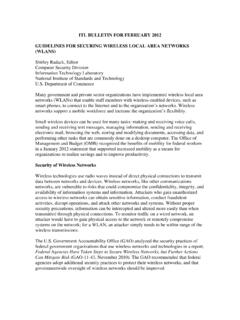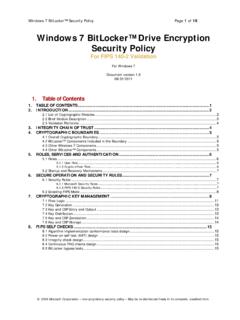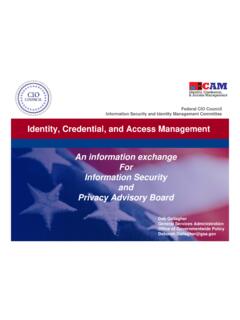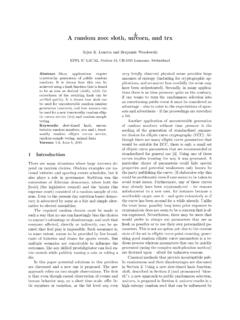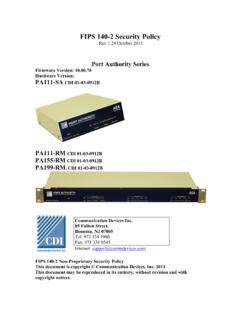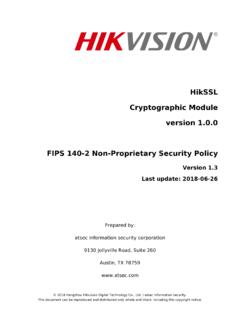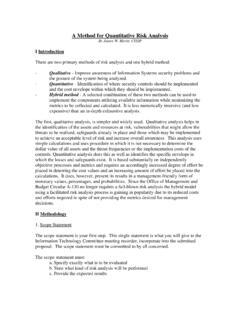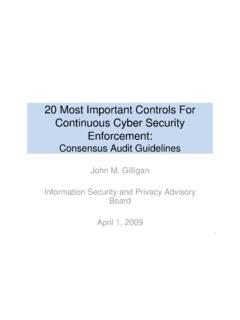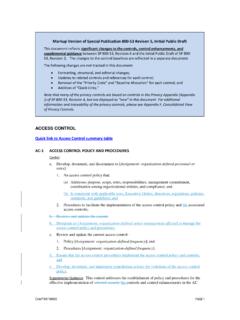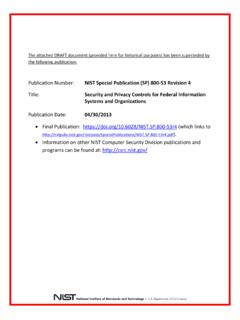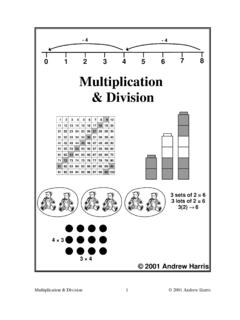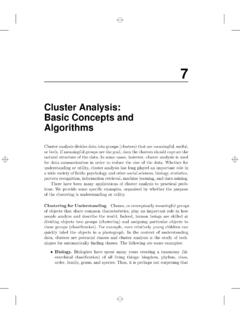Transcription of Approved Security Functions for FIPS PUB 140-2, Security
1 Annex A: Approved Security Functions for FIPS PUB 140-2, Security Requirements for Cryptographic Modules October 12, 2021 Draft Information Technology Laboratory National Institute of Standards and Technology Gaithersburg, MD 20899-8930 Department of Commerce Penny Pritzker, Secretary National Institute of Standards and Technology Willie E. May, Under Secretary for Standards and Technology and Director i Annex A: Approved Security Functions for FIPS PUB 140-2, Security Requirements for Cryptographic Modules 1. Introduction Federal Information Processing Standards Publication (FIPS) 140-2, Security Requirements for Cryptographic Modules, specifies the Security requirements that are to be satisfied by the cryptographic module utilized within a Security system protecting sensitive information within computer and telecommunications systems (including voice systems).
2 The standard provides four increasing, qualitative levels of Security : Level 1, Level 2, Level 3, and Level 4. These levels are intended to cover the wide range of potential applications and environments in which cryptographic modules may be employed. The Security requirements cover eleven areas related to the secure design and implementation of the cryptographic module. These areas include the following: 1. Cryptographic Module Specification 2. Cryptographic Module Ports and Interfaces 3. Roles, Services, and Authentication 4. Finite State Model 5. Physical Security 6. Operational Environment 7. Cryptographic Key Management 8. Electromagnetic Interference/Electromagnetic Compatibility (EMI/EMC) 9. Self Tests 10. Design Assurance 11. Mitigation of Other Attacks The Cryptographic Module Validation Program (CMVP - ) validates cryptographic modules to FIPS 140-2 and other cryptography based standards.
3 The CMVP is a joint effort between NIST and the Canadian Centre for Cyber Security (CCCS - ). Modules validated as conforming to FIPS 140-2 are accepted by the Federal agencies of both countries for the protection of sensitive information (United States) or Designated information (Canada). In the CMVP, vendors of cryptographic modules use independent, accredited testing laboratories to have their modules tested. Organizations wishing to have validations performed would contract with the laboratories for the required services. 2. Purpose The purpose of this document, and of Annexes C and D, is to provide a list of the Approved Security Functions applicable to FIPS 140-2. Annex C lists the Approved Random Bit Generators, while Annex D shows the Approved Key Establishment Methods. The remaining Approved Security Functions are listed in this Annex.
4 The Annexes also provide the links to the descriptions of the allowed algorithms. ii Contents 1. Introduction .. 1 2. Purpose .. 1 ANNEX A: Approved Security Functions .. 1 Transitions .. 1 Symmetric Key Encryption and Decryption (AES, TDEA) .. 1 1. Advanced Encryption Standard (AES) .. 1 2. Triple-DES Encryption algorithm (TDEA) .. 2 Digital Signatures (DSA, RSA and ECDSA) .. 2 1. Digital Signature Standard (DSS) .. 2 Secure Hash Standard (SHS) .. 2 1. Secure Hash Standard (SHS) (SHA-1, SHA-224, SHA-256, SHA-384, SHA-512, SHA-512/224 and SHA-512/256) .. 2 SHA-3 Standard .. 2 1. SHA-3 Hash Algorithms (SHA3-224, SHA3-256, SHA3-384, SHA3-512) .. 2 2. SHA-3 Extendable-Output Functions (XOF) (SHAKE128, SHAKE256) .. 2 3. SHA-3 Derived Functions : cSHAKE, KMAC, TupleHash, and ParellelHash .. 2 Message Authentication (Triple-DES, AES and HMAC).
5 2 1. Triple-DES .. 2 2. AES .. 3 3. HMAC .. 3 Document Revisions .. 4 NIST Computer Security division Page 1 10/12/2021 ANNEX A: Approved Security Functions Annex A provides a list of the Approved Security Functions applicable to FIPS 140-2. The categories include transitions, symmetric key encryption and decryption, digital signatures, message authentication and hashing. Transitions National Institute of Standards and Technology, Recommendation for Transitioning the Use of Cryptographic Algorithms and Key Lengths, Special Publication 800-131A, Revision 2, March 2019. Symmetric Key Encryption and Decryption (AES, TDEA) 1. Advanced Encryption Standard (AES) National Institute of Standards and Technology, Advanced Encryption Standard (AES), Federal Information Processing Standards Publication 197, November 26, 2001.
6 National Institute of Standards and Technology, Recommendation for Block Cipher Modes of Operation, Methods and Techniques, Special Publication 800-38A, December 2001. National Institute of Standards and Technology, Recommendation for Block Cipher Modes of Operation: Three Variants of Ciphertext Stealing for CBC Mode, Addendum to Special Publication 800-38A, October 2010. National Institute of Standards and Technology, Recommendation for Block Cipher Modes of Operation: The CCM Mode for Authentication and Confidentiality, Special Publication 800-38C, May 2004. National Institute of Standards and Technology, Recommendation for Block Cipher Modes of Operation: Galois/Counter Mode (GCM) and GMAC, Special Publication 800-38D, November 2007. National Institute of Standards and Technology, Recommendation for Block Cipher Modes of Operation: The XTS-AES Mode for Confidentiality on Storage Devices, Special Publication 800-38E, January 2010.
7 National Institute of Standards and Technology, Recommendation for Block Cipher Modes of Operation: Methods for Key Wrapping, Special Publication 800-38F, December 2012. IEEE Standards Association, Standard for Local and metropolitan area networks, Media Access Control (MAC) Security , Amendment 2: Extended Packet Numbering, , February 12, 2013. National Institute of Standards and Technology, Recommendation for Block Cipher Modes of Operation: Methods for Format-Preserving Encryption, Special Publication 800-38G, March 2016. NIST Computer Security division Page 2 10/12/2021 2. Triple-DES Encryption algorithm (TDEA) National Institute of Standards and Technology, Recommendation for the Triple Data Encryption algorithm (TDEA) Block Cipher, Special Publication 800-67, Revision 2, November 2017.
8 National Institute of Standards and Technology, Recommendation for Block Cipher Modes of Operation, Methods and Techniques, Special Publication 800-38A, December 2001. Appendix E references modes of the Triple-DES algorithm . National Institute of Standards and Technology, Recommendation for Block Cipher Modes of Operation: Methods for Key Wrapping, Special Publication 800-38F, December 2012. 3. NOTE. The use of SKIPJACK is Approved for decryption only. The SKIPJACK algorithm has been documented in Federal Information Processing Standards Publication 185. This publication is obsolete and has been withdrawn. Digital Signatures (DSA, RSA and ECDSA) 1. Digital Signature Standard (DSS) National Institute of Standards and Technology, Digital Signature Standard (DSS), Federal Information Processing Standards Publication 186-4, July 2013.
9 Secure Hash Standard (SHS) 1. Secure Hash Standard (SHS) (SHA-1, SHA-224, SHA-256, SHA-384, SHA-512, SHA-512/224 and SHA-512/256) National Institute of Standards and Technology, Secure Hash Standard, Federal Information Processing Standards Publication 180-4, August, 2015. SHA-3 Standard 1. SHA-3 Hash Algorithms (SHA3-224, SHA3-256, SHA3-384, SHA3-512) National Institute of Standards and Technology, SHA-3 Standard, Federal Information Processing Standards Publication 202, August, 2015. 2. SHA-3 Extendable-Output Functions (XOF) (SHAKE128, SHAKE256) National Institute of Standards and Technology, SHA-3 Standard, Federal Information Processing Standards Publication 202, August, 2015. 3. SHA-3 Derived Functions : cSHAKE, KMAC, TupleHash, and ParallelHash National Institute of Standards and Technology, SHA-3 Derived Functions : cSHAKE, KMAC, TupleHash, and ParallelHash Special Publication 800-185, December 2016 Message Authentication (Triple-DES, AES and HMAC) 1.
10 Triple-DES National Institute of Standards and Technology, Computer Data Automation, Federal Information Processing Standards Publication 113, 30 May 1985. This standard has been withdrawn by NIST on September 1, 2008. The CMVP will accept, until December 31, 2017, the new submissions with the NIST Computer Security division Page 3 10/12/2021 claims of vendor affirmation to this standard. The existing validations with the claim of Triple-DES MAC complying with FIPS 113 will remain in place. National Institute of Standards and Technology, Recommendation for Block cipher Modes of Operation: The CMAC Mode for Authentication, Special Publication 800-38B, May 2005. 2. AES National Institute of Standards and Technology, Recommendation for Block Cipher Modes of Operation: The CMAC Mode for Authentication, Special Publication 800-38B, May 2005.
